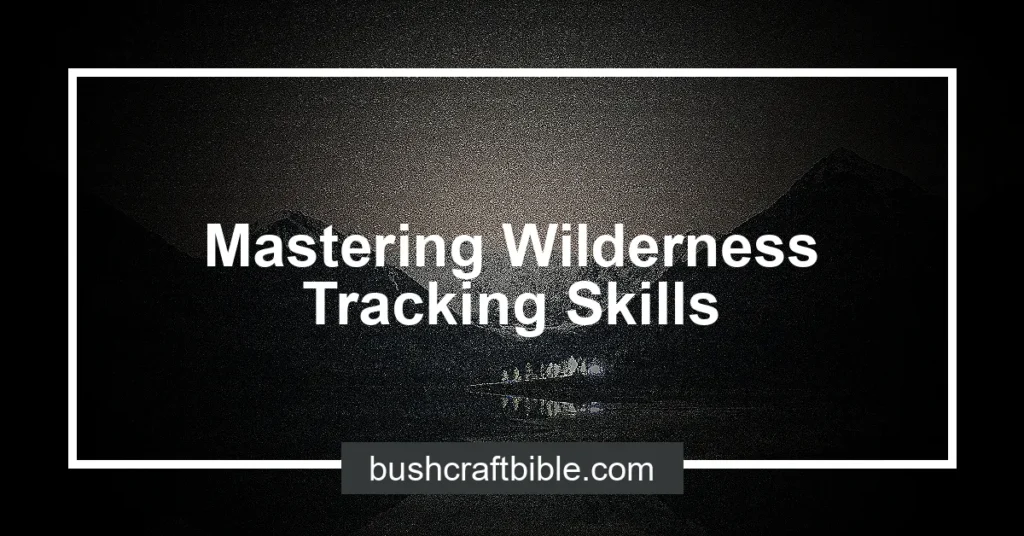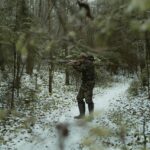

Wilderness tracking skills are essential for anyone venturing into the outdoors. These skills enable individuals to identify animal tracks and signs, enhancing their understanding and appreciation of wildlife and the natural environment.
Developing wilderness tracking skills also fosters self-sufficiency and independence in outdoor activities.
Understanding the basics of wilderness tracking is crucial for anyone interested in interacting with the ecosystem in a meaningful way. By learning to track animals and interpret their signs, individuals can deepen their awareness and knowledge of wildlife, leading to better protection of pets, livestock, and garden produce.
Wilderness tracking skills also provide opportunities for individuals to connect with nature and the outdoors.
Check out this Youtube video: Enhance your wilderness tracking skills and learn the six disciplines of tracking with this informative video.
Introduction
The importance of developing wilderness tracking skills cannot be overstated. These skills not only allow individuals to establish the presence, behavior, movements, and habitat of wildlife, but also contribute to the conservation and protection of the natural environment.
Additionally, outdoor skills education, including tracking, foraging, and shelter-building, offers numerous benefits for health, social networks, and overall wellbeing.
The Fundamentals of Tracking
Understanding Animal Tracks and Signs
For a beginner, understanding animal tracks and signs is crucial. Look for imprints of paws, claws, and tails.
Signs like scat and trails are also essential. Knowing the distinction between herbivore and carnivore scat is a game-changer!
Identifying Different Types of Footprints and Tracks in the Wilderness
Identifying different types of footprints and tracks in the wilderness revolves around keen observation. Pay attention to the depth, shape, and arrangement of prints.
Recognizing the distinct features of wolf, coyote, fox, and deer tracks is essential for survival. Familiarizing oneself with the nuances of each print is like deciphering nature’s secret code.
| Animal Tracks | Characteristics |
|---|---|
| Wolf | Large, symmetrical, and claw marks are evident. |
| Coyote | Smaller than wolves with visible nail imprints. |
| Fox | Delicate, with oval-shaped prints and non-retractable claws. |
| Deer | Heart-shaped prints with parallel dewclaw imprints. |
Deepening Your Tracking Skills
Building a Portfolio of Tracks and Signs for Different Animal Species
To build a comprehensive portfolio of tracks and signs for different animal species, it’s crucial to familiarize yourself with the specific characteristics of each species. For instance, document the distinct paw prints of wolves, coyotes, foxes, and other wildlife.
Collecting and cataloging scat samples can also provide valuable insights into the presence and behavior of various animals.
Enhancing Your Awareness of Surrounding Wildlife
Elevating your awareness of surrounding wildlife involves engaging all your senses. Paying close attention to sounds, smells, and visual cues can help you detect the presence of animals.
Additionally, studying the behaviors and habits of local wildlife will aid in recognizing their tracks, signs, and overall interactions with the environment.
The Comprehensive Guide to Tracking Skills
Implementing Effective Techniques for Tracking in Various Terrains
In diverse terrains, an effective tracking technique involves observing the landscape for key indicators such as disturbed vegetation, animal droppings, and tracks. By understanding animal behaviors and their preferred habitats, you can anticipate their movements and improve your tracking success.
For instance, in dense forests, paying attention to broken twigs or disturbed foliage can provide valuable clues. In rocky environments, examining areas with loose soil or sand can reveal tracks left by animals.
By honing these observational skills, trackers can adapt to different terrains and enhance their success rates.
Using Technology and Tools to Aid in Wilderness Tracking
Utilizing modern technology and tools can greatly enhance wilderness tracking efforts. For instance, GPS telemetry allows for precise tracking of animal movements, aiding researchers and wildlife conservationists in monitoring and protecting various species.
Additionally, camera tracking technology provides valuable insights for wildlife observation and research. In outdoor settings, advanced camera systems equipped with infrared and motion sensors enable the capture of wildlife activities during low-light conditions, contributing to a deeper understanding of animal behaviors in their natural habitats.
| Tracking Technique | Terrain | Example |
|---|---|---|
| Visual observation | Forests | Observing broken twigs and disturbed foliage |
| Soil examination | Rocky areas | Examining loose soil for animal tracks |
| GPS telemetry | Various terrains | Precise tracking of animal movements for conservation efforts |
| Camera tracking technology | Outdoor settings | Capturing wildlife activities during low-light conditions |
By combining traditional tracking methods with cutting-edge technology, trackers can gain a more comprehensive understanding of animal behaviors and movements across diverse terrains, ultimately contributing to wildlife conservation and research efforts.
Remember, when it comes to tracking in the wilderness, a keen eye and modern tools can make all the difference.
Hunters and Trackers
The Role of Tracking Skills in Hunting Activities
Tracking skills play a crucial role in hunting activities as they enable hunters to locate and pursue game effectively. By analyzing animal tracks, signs, and trails, hunters can anticipate the movement patterns of their prey, increasing their chances of a successful hunt.
These skills also aid in understanding the behavior and habits of the targeted animals, leading to a more strategic approach in hunting.
Learning From Traditional Trackers and Exploring Modern Tracking Methods
Learning from traditional trackers provides a wealth of knowledge about indigenous techniques for wilderness tracking. Their methods, honed over generations, offer valuable insight into understanding the natural environment and animal behavior.
On the other hand, modern tracking methods leverage technology and scientific advancements, incorporating tools such as GPS devices and motion-sensor cameras. By combining traditional wisdom with modern innovations, hunters can enhance their tracking skills for more efficient and ethical hunting practices.
Developing Your Expertise
Perfecting the Art of Stealth and Patience in Wilderness Tracking
Mastering the art of stealth in wilderness tracking involves moving silently and slowly to avoid alerting animals. This includes learning to blend in with the surroundings, being mindful of wind direction, and making minimal noise to remain undetected.
Refining Your Observation and Analysis Skills
Refining observation and analysis skills in wilderness tracking requires acute attention to detail. It involves studying the terrain for clues such as disturbed foliage, broken twigs, animal tracks, and other signs that indicate the presence or movement of wildlife.
The Psychology of Tracking
The psychology of tracking delves into understanding animal behavior through tracking. It involves interpreting clues left behind by animals to gain insights into their movements, habits, and interactions with the environment.
By closely examining animal tracks, scat, and other signs, trackers can discern patterns in behavior, such as feeding or resting areas, territorial boundaries, and migration routes.
Understanding Animal Behavior Through Tracking
Understanding animal behavior through tracking enables trackers to observe and analyze the intricate patterns in wildlife activities. For instance, by identifying the frequency and direction of animal tracks, trackers can determine the animal’s routine movements, preferred habitats, and social behaviors.
This knowledge is crucial for wildlife conservation, as it allows researchers to assess the impact of human activities on animal populations and ecosystems.
Recognizing and Interpreting Patterns in Wilderness Tracking
Recognizing and interpreting patterns in wilderness tracking involves deciphering the unique imprints and trails left by different animal species. By studying the size, shape, and arrangement of tracks, as well as the spacing between them, trackers can identify the species and gain insights into their activities.
Furthermore, tracking patterns facilitate understanding seasonal behaviors, predator-prey relationships, and ecological dynamics, contributing to a comprehensive understanding of wildlife and their habitats.
Wilderness Tracking for Survival
Utilizing Tracking Skills for Safety and Navigation
Utilizing tracking skills is essential for safety and navigation in the wilderness. By being able to identify animal tracks and signs, you can gauge potential threats and locate sources of food and water.
This knowledge also aids in understanding the behavior of wild animals, allowing you to avoid dangerous encounters and make informed decisions about your surroundings. Additionally, tracking skills can help you navigate through unfamiliar terrain by following trails and interpreting signs of wildlife movement.
Case Studies and Examples of Wilderness Tracking in Survival Situations
In a real-life survival situation, wilderness tracking skills can make a life-saving difference. Take, for instance, the remarkable story of a lost hiker who used his tracking expertise to follow deer trails, leading him to fresh water sources.
Another compelling example is the experience of a stranded camper who identified bear tracks and wisely chose a different path to avoid potential danger. These case studies underline the critical role of tracking skills in enhancing survival prospects in the wild.
Training and Education
Formal Training Programs for Wilderness Tracking Skills
The Survival University offers a diverse range of courses, including basic survival skills like fire-building and shelter construction, as well as advanced wilderness navigation. Students can learn from experienced instructors and gain practical knowledge in wilderness tracking.
Self-Study and Practical Application for Mastering Wilderness Tracking
Engaging in self-study for mastering wilderness tracking involves developing a keen awareness of the environment to predict and locate the best places for tracking various species. Practical application is vital in building a unique portfolio of tracks and signs associated with each species, enhancing one’s tracking skills.
Wilderness Tracking Ethics
Responsible and Sustainable Tracking Practices
The Impact of Human Presence on Wilderness Tracking
Advancing Your Tracking Abilities
Hey there, wilderness enthusiasts! Are you looking to push the boundaries of your tracking skills?
Well, imagine this: honing your tracking abilities to the point where you can follow the faintest trail through dense forests with the precision of a hawk hunting its prey. That’s the level we’re aiming for!
By consistently challenging and pushing the limits of your tracking skills, you’ll elevate your wilderness tracking game to a whole new level.
Now, let’s talk about challenging yourself with advanced tracking scenarios. Think of it as leveling up in a video game, but in real life!
By exposing yourself to increasingly complex tracking situations, you’ll develop the expertise to handle any tracking challenge that comes your way. It’s like going from tracking a slow-moving deer to tracking a crafty fox, then ultimately to tracking elusive and quick-witted prey like a rabbit.
Embracing these advanced scenarios will ensure that you’re fully prepared for any tracking challenge the wilderness throws at you.
So, gear up and get ready to elevate your tracking prowess to unmatched levels. The wilderness is waiting, and with your advanced tracking skills, you’ll conquer it like never before.
Stay wild,
Jason Hart
Recommended Amazon Products for Wilderness Tracking Skills
Here’s a curated list of products that can help you develop or enhance your wilderness tracking skills. These recommendations are based on the functionality, popularity, and customer reviews of the products.
Garmin GPSMAP 64st


The Garmin GPSMAP 64st is equipped with a high-sensitivity GPS and GLONASS receiver and a quad helix antenna that allows for superior reception, making it easier to track in various terrains. The device also comes with preloaded TOPO US 100K maps and a one-year BirdsEye Satellite Imagery subscription, enhancing its functionality for wilderness tracking.
Pros and Cons
| Pros | Cons |
|---|---|
| High-sensitivity GPS receiver | Relatively expensive |
| Preloaded topographic maps | Complex interface for beginners |
Nikon 7576 MONARCH 5


The Nikon 7576 MONARCH 5 provides a wide field of view, and its extra-low dispersion glass ensures bright, high-resolution images, which are beneficial for observing surrounding wildlife in the wilderness. Its lightweight and durable design make it easy to carry and handle during tracking activities.
Pros and Cons
| Pros | Cons |
|---|---|
| Wide field of view | Higher price point compared to other brands |
| Lightweight and durable design | Not waterproof |
Bushnell Trophy Cam HD


The Bushnell Trophy Cam HD is a reliable and weatherproof trail camera that captures high-quality images and videos, aiding in the documentation of animal tracks and behavior in the wilderness. Its extended battery life and adjustable settings enhance its functionality for continuous tracking activities.
Pros and Cons
| Pros | Cons |
|---|---|
| Weatherproof and durable | Limited night vision range |
| Extended battery life | Slightly bulkier compared to other models |
SAS Survival Handbook


The SAS Survival Handbook is a comprehensive guide that provides valuable knowledge and techniques for survival and wilderness tracking, making it an essential resource for honing tracking skills. This book offers practical advice and illustrations on tracking, shelter building, and foraging, among others.
Pros and Cons
| Pros | Cons |
|---|---|
| Comprehensive survival guide | Limited emphasis on technology and tools |
| Practical advice and illustrations | Limited real-life tracking examples |
Top Recommended Product for Wilderness Tracking Skills
If you’re looking for the best solution to enhance your wilderness tracking skills, we highly recommend the Garmin GPSMAP 64st. Its high-sensitivity GPS receiver, preloaded topographic maps, and functionality make it an ideal choice for tracking in various terrains.


Ready to improve your wilderness tracking skills? Check out the Garmin GPSMAP 64st today for the best results!


Conclusion
Wilderness tracking skills are essential for survival in the outdoor environment. They enable individuals to navigate through rough terrain, locate water sources, and find food.
These skills are crucial for hikers, campers, and outdoor enthusiasts to ensure their safety and well-being.
Moreover, developing wilderness tracking skills can also enhance one’s understanding of nature and wildlife. By learning to interpret animal tracks, signs, and behaviors, individuals can gain a deeper appreciation for the natural world around them.
This knowledge can also aid in wildlife conservation efforts and the protection of endangered species.
Wilderness tracking skills play a vital role in outdoor activities and can be life-saving in emergency situations. By honing these skills, individuals can boost their confidence in exploring the wilderness, while also fostering a stronger connection with nature.
Whether for recreation or practical purposes, mastering these skills is an invaluable asset for anyone venturing into the great outdoors.
Frequently Asked Questions
How do you get good at tracking animals?
How do you track wild animals?
How do you keep track of animals?
How do you track animals and humans?
What types of data do tracking tags give scientists?
Reference Links
- https://support.apple.com/guide/motion/advanced-tracking-strategies-motn20fba77/mac
- https://www.sciencedirect.com/science/article/pii/S2666389920302646
- https://academic.oup.com/beheco/article/25/3/450/509254








